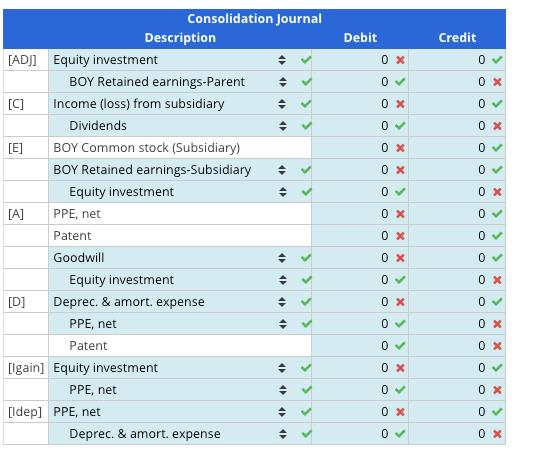Question
Assume that a parent company acquired a subsidiary on January 1, 2012, for $892,000. The purchase price was $359,000 in excess of the book value
Assume that a parent company acquired a subsidiary on January 1, 2012, for $892,000. The purchase price was $359,000 in excess of the book value of the subsidiary’s Stockholders’ Equity on the acquisition date. On the acquisition date, the subsidiary’s stockholders' equity was comprised of $390,000 of no-par common stock and $143,000 of retained earnings. The Acquisition Accounting Premium (AAP) was assigned as follows: an increase of $33,000 in accounts receivable that were entirely collected during the year after the acquisition, an increase of $65,000 for property, plant, and equipment that has 10 years of remaining useful life, $124,000 for an unrecorded patent with an 8-year remaining life and $137,000 for goodwill. All amortizable components of the AAP are amortized using the straight-line method.
On January 1, 2014, the parent sold Equipment to the subsidiary for a cash price of $134,700. The parent had acquired the equipment at a cost of $130,800 and depreciated the equipment over its 12-year useful life using the straight-line method (no salvage value). The parent had depreciated the equipment for 2 years at the time of sale. The subsidiary retained the depreciation policy of the parent and depreciates the equipment over its remaining 10-year useful life.
Following are the financial statements of the parent and its subsidiary as of December 31, 2016. The parent uses the cost method of pre-consolidation investment bookkeeping.

1 Prior to preparing consolidated financial statements, compute the amount of equity income the parent would have reported for the year ended December 31, 2016, assuming the parent applied the equity method instead of the cost method of pre-consolidation bookkeeping.
2. Prepare the consolidation entries for the year ending December 31, 2016.

3. Prepare the consolidation spreadsheet for the year ending December 31, 2016.

Income statement Sales Cost of goods sold Gross profit Deprec. & amort. Expense Operating expenses Interest expense Total expenses Income (loss) from subsidiary Net income Parent Subsidiary Dividends Ending retained earnings $1,300,000 $598,000 Assets (715,000) (364,000) Cash 585,000 234,000 Accounts receivable (39,000) (26,000) Inventory (390,000) (104,000) Equity investment (19,500) (6,500) Property, plant & equipment, net (448,500) (136,500) Other assets Total assets 45,500 $182,000 Statement of retained earnings BOY retained earnings Net income $715,000 182,000 Balance sheet (149,500) $747,500 $97,500 Liabilities and stockholders' equity Accounts payable Accrued liabilities $325,000 Notes payable 97,500 Common stock (45,500) Retained earnings $377,000 Total liabilities and equity Parent Subsidiary $117,000 $78,000 156,000 117,000 364,000 182,000 892,000 442,000 169,000 2,140,000 312,000 286,000 $975,000 $70,200 59,800 78,000 $325,000 32,500 195,000 840,000 390,000 747,500 377,000 2,140,000 $975,000
Step by Step Solution
3.54 Rating (161 Votes )
There are 3 Steps involved in it
Step: 1
1 To compute the equity income using the equity method we need to determine the parents share of the subsidiarys net income We already have the net income of the subsidiary which is 97500 The parents ...
Get Instant Access to Expert-Tailored Solutions
See step-by-step solutions with expert insights and AI powered tools for academic success
Step: 2

Step: 3

Ace Your Homework with AI
Get the answers you need in no time with our AI-driven, step-by-step assistance
Get Started


